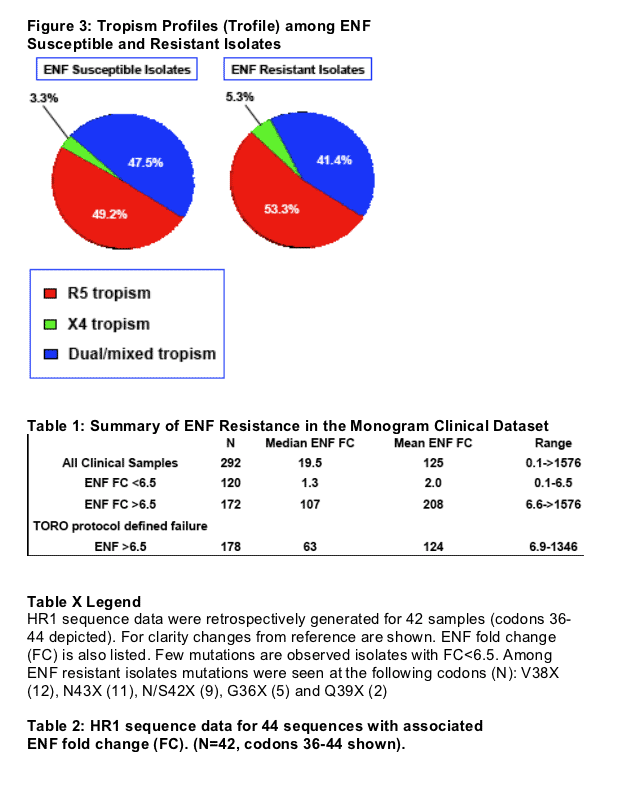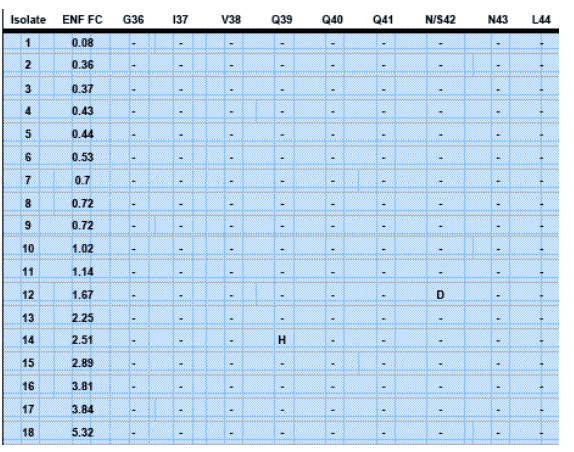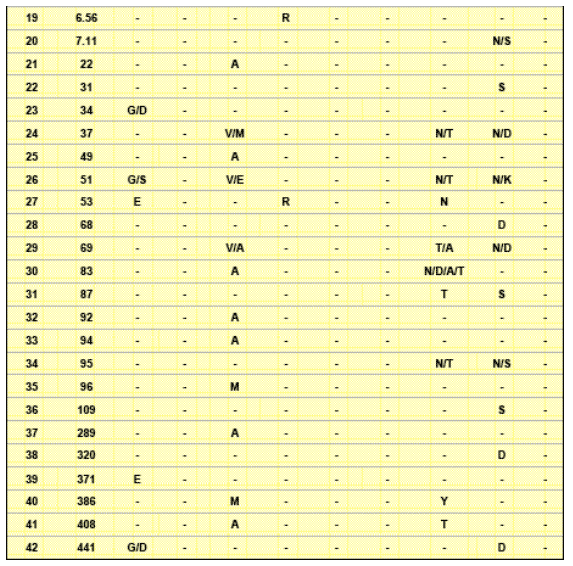 |
 |
 |
| |
Distribution Of Susceptibility Among HIV-1 Clinical Samples Submitted For
Enfuvirtide (ENF) Resistance Testing
|
| |
| |
Reported by Jules Levin
ICAAC, Sept 2006, San Francisco
E. P. COAKLEY, J. WHITCOMB, W. HUANG, R. PESANO, T.
BUI, C. PETROPOULOS
Monogram Biosciences, South San Francisco, CA
Poster H-247 #389
BACKGROUND: ENF was the first entry inhibitor approved for the treatment of HIV infection. To date, limited surveillance data defining phenotypic ENF susceptibility in clinical practice has been reported.
METHODS
ENF susceptibility was measured using PhenoSense HIV Entry; a single-cycle assay that utilizes pseudovirions incorporating patient derived HIV env to infect cells expressing CD4 and both coreceptors CXCR4 and CCR5 (Figure 1 (center) (ENTRY VALIDATION reference)
Enfuvirtide resistance was defined at 6.5 fold change (FC) from reference. This is the FC at the 99th percentile for the distribution of baseline (wildtype) viruses within the TORO dataset (n=220) (Figures 1a-d)
The isolates evaluated were from clinical samples submitted for routine ENF susceptibility testing (N=292) (Table 1). Comparisons were made within this dataset by ENF susceptibility/resistance. The level of ENF resistance in the clinical dataset was also compared to that observed among ENF resistant isolates within the TORO dataset of isolates from individuals meeting the protocol defined endpoint criteria
HR1 sequence data were defined retrospectively in a random selection of these isolates (n=42) (Table 2).
Tropism data were generated retrospectively on all samples undergoing ENF susceptibility testing (N=292) Figure 3
Where available the associated NRTI, NNRTI and PI phenotypic data (n=139) and replication capacity (RC) (PhenoSense) were also evaluated (n=128) (Table 3)
Comparisons were made within the clinical data set by ENF susceptibility profile for HR1 sequence, tropism profile, antiretroviral resistance and RC
RESULTS
288 unique samples submitted for routine ENF susceptibility testing were evaluated (Figure 1 and Table 1)
The observed distribution of ENF susceptibilities described a continuous range from 0.1 FC to greater than 1576 FC
41% of the viruses were classified as ENF susceptible and 59% as ENF resistant (FC>6.5). The median FC (mean, range) of ENF resistant isolates was 109 (208, 6.74-1576) and susceptible isolates was 1.3 (2.0, 0.1-6.4).
Among ENF resistant isolates in this clinical dataset the median (mean) FC was 109 (208) (n=171). This is higher than the observed median (mean) FC for ENF resistant isolates among the TORO endpoint group in which the median (mean) FC was 63 (124) (n=178, p=0.001)
Retrospective coreceptor tropism profiling (Trofile, n=288) demonstrated that the proportions R5, dual/mixed and X4 were 51.7%, 43.8% and 4.5%, respectively. The tropism profiles were not different in the ENF susceptibility and resistant groups (Figure 2)
HR1 sequence data (n=42, codons 36-44) demonstrated few changes among ENF susceptible isolates (n=18) and more frequent mutations (incl. mixtures) among ENF resistant isolates (n=24) (Table 2)
The levels of resistance for NRTI, NNRTI and PI/r were generally high. Comparing ENF resistant and susceptible isolates only the levels of PI/r resistance were higher in the ENF resistant isolates (Table 3)
The median pol RC among ENF susceptible (RC=57% (n=57)) and resistant (RC=45% (n=71)) isolates
AUTHOR CONCLUSIONS
This is the first description of phenotypic ENF susceptibility profiles in clinical isolates by the Monogram Entry assay. The observed distribution in ENF susceptibility is broad and includes both ENF susceptible and resistant isolates.
Among ENF resistant isolates, ENF FCs are higher than those observed for ENF resistant isolates within the TORO trial dataset.
Coreceptor tropism profiles are similar to those previously reported in experienced populations and were not different between ENF resistant and susceptible isolates
The levels PI, NNRTI and NRTI resistance were high and were higher for PI's among ENF resistant isolates



|
| |
|
 |
 |
|
|